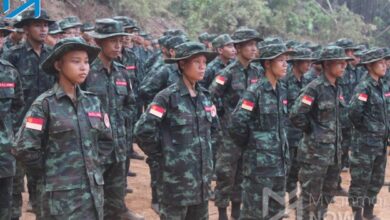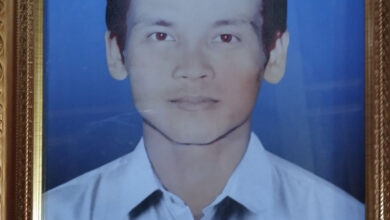
New evidence suggests that three monks who were among the victims of a massacre in southern Shan State last week were tortured before their deaths, according to local residents.
The monks have been identified as Ven. Pandi, the 45-year-old abbot of the monastery in the village of Nanneint, Pinlaung Township, where the incident occurred; Ven. Thawbaka, 66; and Ven. Kaw Vida, also 66.
They were killed, along with 26 other victims, in the monastery compound on March 11.
In the weeks before the incident, battles had broken out continuously in the areas of southern Shan State bordering Myanmar’s administrative capital of Naypyitaw, following resistance forces’ February 24 attack on a security checkpoint held jointly by the junta and an allied ethnic Pa-O militia.
According to a resident of Nanneint, which is a predominantly Pa-O village, bruises and other injuries were found on the monks’ bodies.
“There were injuries on their knees that looked like knife cuts. Their teeth were knocked out as well. All of their injuries suggested that they were beaten to death,” the man said, citing people who had seen the bodies before their cremation.
People who prepared the monks’ remains for cremation said the bodies had no bullet wounds, but did have knife wounds, bruises, and dislocated elbow joints, another man from Nanneint said.
“They were beaten inhumanely. The bodies had already started decomposing when we found them. I saw with my own eyes that one of the elderly monks had knife cuts on his face,” he added.
The monks’ bodies were cremated on Tuesday in Saung Pyaung, a village located about 5km from Nanneint.
Nanneint residents and surviving relatives claim the other victims were just ordinary civilians who had stayed behind with the monks to look after the monastery.
The villager who saw cuts on one of the bodies added that he received a phone call from the head monk, Ven. Pandi, on the morning that he was killed. He said the monk told him that “troops” were approaching the monastery, and then hung up.
“He said they were coming from the east of the village and hung up the phone, saying it wasn’t OK for him to talk anymore. He didn’t say which organisation they were from,” the villager said.
Armed forces operating in the area, including junta forces, have begun casting blame on one another for the raid and massacre, as no conclusive evidence has emerged to settle which armed group was responsible.
However, photos of the scattered dead bodies inside the monastery compound were posted on pro-junta social media pages with captions about “teaching a lesson to the Kayah PDF,” referring to ethnic Karenni resistance forces, such as the Karenni Nationalities Defence Force (KNDF).
In a March 13 statement concerning the situation in the area, junta spokesperson Gen. Zaw Min Tun said the military would take “severe” action against the KNDF and its ally, the Karenni Army (the armed wing of the Karenni National Progressive Party), for disrupting peace in the Pa-O Self-Administered Zone, which includes Pinlaung Township.
However, he did not directly address the fact that monks were among the massacre’s victims and referred to reports of civilians being killed as “rumours.”
The Pa-O National Organisation (PNO), a group known to have collaborated with the military council, also released a statement on March 14 strongly condemning the KNDF’s actions in the Pa-O region, accusing it of turning the area into a battleground and of targeting civilians. It also blamed the group for the Nanneint massacre.
Following the rapid spread of Pa-O-language social media posts about the incident—many evidently aimed at inciting ethnic animosity—the PNO held a ceremony in Taunggyi on March 15 to “condemn the actions of” the KNDF and its allies.
The KNDF and other anti-junta forces continue to insist, however, that the massacre was perpetrated by junta soldiers.
Mawi, the deputy commander-in-chief of the KNDF, claimed military forces were trying to incite racial and religious conflict by killing monks and civilians inside a monastery compound.
Photos shared on pro-junta social media channels showing primitive, handmade weapons near the bodies of the dead villagers were also intended to mislead, he added.
“The photos are genuine. They’re the same ones we took inside the monastery,” he said, before adding that the weapons were clearly no threat to the soldiers who raided the village.
“They had to know that these little guns that the locals were armed with could not hurt them. They knew full well that they weren’t even aimed at them.”
![Resistance fighters holding heavy weapons ammunition in central Myanmar. (Photo: Freedom Revolution Force [FRF])](https://myanmar-now.org/en/wp-content/uploads/sites/5/2024/04/438869056_443267851680128_1706386881626943924_n-390x220.jpeg)


